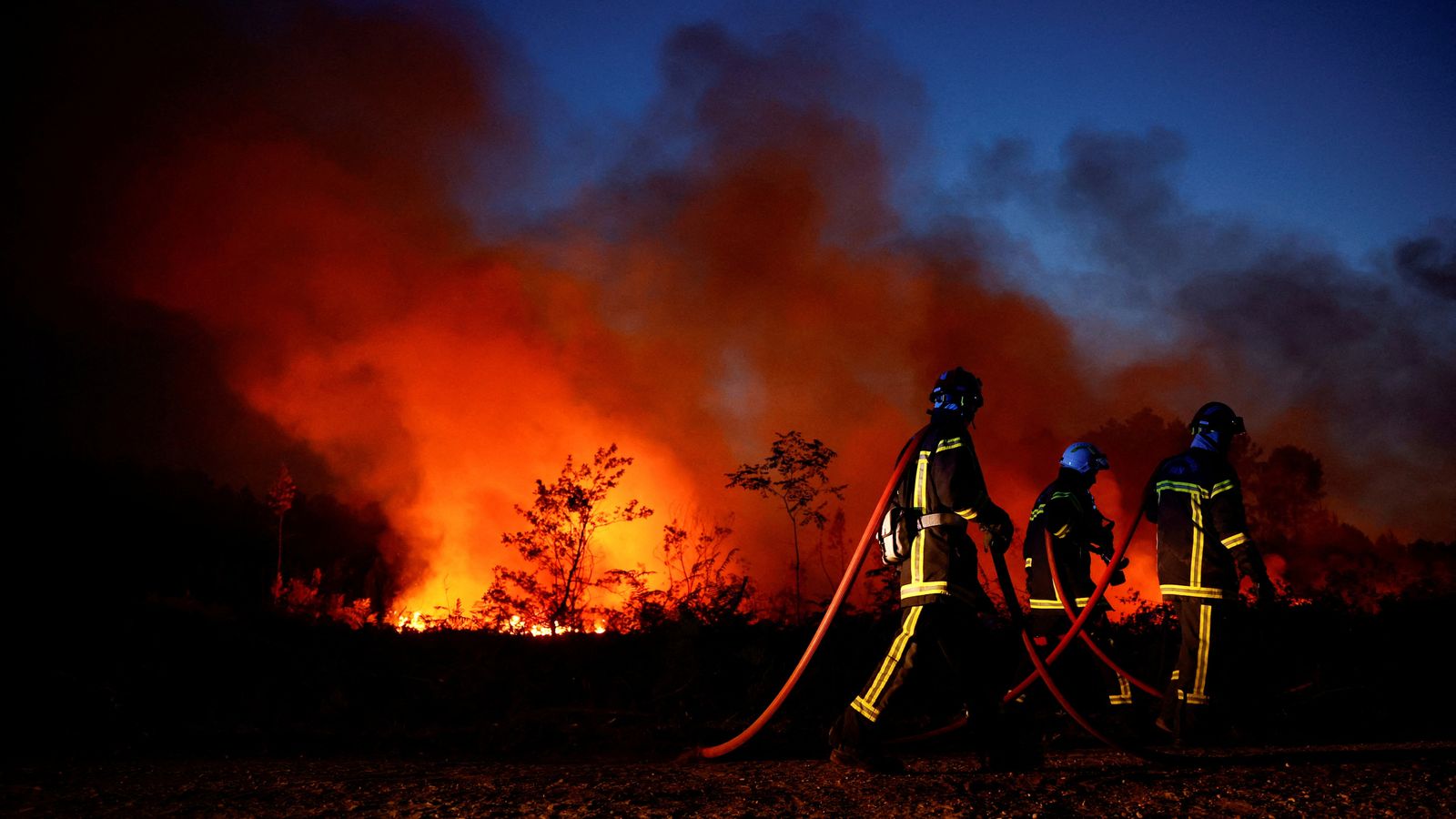Thousands of people have been forced to evacuate their homes as wildfires continue to burn in Spain and France caused by an ongoing heatwave.
Two people were killed in the blazes in Spain with the country’s prime minister linking the deaths to global warming, saying: “Climate change kills.”
That toll comes on top of the hundreds of heat-related deaths reported in the Iberian Peninsula, as high temperatures have gripped the continent and triggered wildfires from Portugal to the Balkan region.
Some areas, including northern Italy, are also experiencing extended droughts.
UK weather – latest: UK could hit 41C – as RAF halts flights from biggest base after runway ‘melts’
In France, heat records were broken and swirling hot winds complicated firefighting efforts in the country’s southwest.
“The fire is literally exploding,” said Marc Vermeulen, the regional fire service chief who described tree trunks shattering as flames consumed them, sending burning embers into the air and further spreading the blazes.
Heatwave in pictures: Wildfires across Europe, droughts and ice pops
Extreme weather: From blankets on glaciers to ice creams for pandas, Europe finds new ways to deal with blistering heatwave
Italy: Crime network who duped lonely men out of more than €1m arrested in international police sting
“We’re facing extreme and exceptional circumstances,” he said.
Authorities evacuated more towns, moving another 14,900 people from areas at risk of finding themselves in the path of the fires.
In all, more than 31,000 people have been forced out of their homes and summer vacation spots in the Gironde region since the wildfires began 12 July.
Three additional planes were sent to join six others already fighting the fires, scooping up seawater into their tanks and making repeated runs through dense clouds of smoke.
More than 200 reinforcements headed to join the 1,500-strong force of firefighters battling night and day to contain the blazes in the Gironde.
Spain, meanwhile, reported a second fatality in two days as it battled its own blazes.
The body of a 69-year-old sheep farmer was found on Monday in the same hilly area where a 62-year-old firefighter died a day earlier when he was trapped by flames in the northwestern Zamora province.
More than 30 forest fires around Spain have forced the evacuation of thousands of people and blackened 85 square miles (220 square km) of forest and scrub.
Passengers on a train through Zamora got a frightening, up-close look at a blaze when their train came to a stop in the countryside.
Video showed about a dozen passengers becoming alarmed as they looked out of the windows at the flames encroaching on both sides of the track.
Please use Chrome browser for a more accessible video player
Almost 600 heat-related deaths have been reported in Spain and neighbouring Portugal, where temperatures reached 47C (117F) earlier this month.
The heat wave in Spain was forecast to ease on Tuesday, but the respite will be brief as temperatures rise again on Wednesday, especially in the dry western Extremadura region.
Read more:
Roads close, ‘frightening’ fires break out and drought sets in as Portugal’s temperatures soar
Heatwave in pictures: Wildfires across Europe, droughts and ice pops
The Balkans region is expected to get the worst of the heat later this week but has already seen sporadic wildfires.
Early on Monday, authorities in Slovenia said firefighters managed to bring one blaze under control.
Keep out of the sun between 11am and 3pm and avoid physical exertion
Drink plenty of fluids and avoid excess alcohol
Close curtains in rooms that face the sun
Never leave anyone in a parked car – and check in on elderly and vulnerable neighbours
Walk in the shade, apply sunscreen and wear a wide-brimmed hat
Check medicines can be stored according to instructions – and check that your fridges, freezers and fans are working properly
Watch the Daily Climate Show at 3.30pm Monday to Friday, and The Climate Show with Tom Heap on Saturday and Sunday at 3.30pm and 7.30pm.
All on Sky News, on the Sky News website and app, on YouTube and Twitter.
The show investigates how global warming is changing our landscape and highlights solutions to the crisis.








